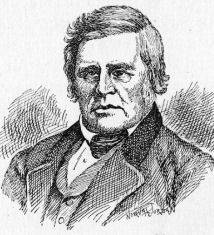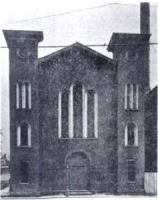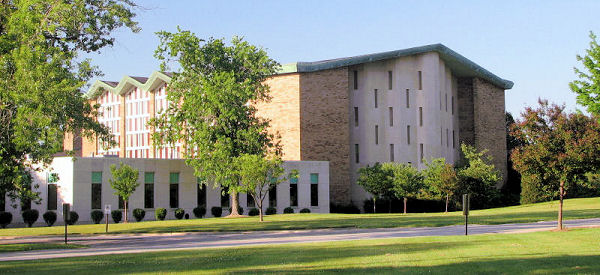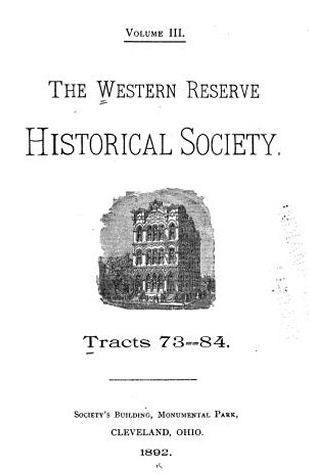|
|
Leonard Case's Great Gift to the Jews of Cleveland |
|
|
Land for Their First Synagogue The Story The Philosemitism of Leonard Case Srr Webkeeper's Note |
||
| The story in brief In a deed signed on August 13, 1843 Cleveland's first congregation, The Israelitic Society, was given land for its first synagogue. This was a great gift - unusual for its time and even in ours. We discuss why land agent, banker and former City Council president Leonard Case, a Protestant, would have been inclined to help Cleveland's first Jews. We learn that while similar gifts to churches had no conditions, this gift was conditional. We try to explain why the deed shows a man named John Woolsey as the donor. Then we tell how a 260-year old story of persecution found its way to this web page. The full story follows below. ●
|
|||||||||||||||||||
A complete reading of the deeds of these gifts reveals a fact not mentioned in any histories of the time: only the gift to the Israelitic Society was conditional. (See the condition in the deed.) We quote from the deed:
While the gifts to churches
had no conditions, the churches had been established
longer. In contrast, the Israelitic Society, formed in
1840, did not get a charter until 1842. The deed was signed, sealed and delivered on August 13, 1843, two years after the first gifts to churches were made While the other deeds were promptly recorded, this deed was not recorded until September 17, 1844 - a delay of 13 months. These delays may be additional indications of the congregation's lack of readiness to move ahead. Who was Leonard Case Sr?
In 1967 Case and Western Reserve joined to create Case Western Reserve University. The Case School of Engineering is today part of CWRU. We also know that Leonard Case Sr, perhaps Cleveland's first philanthropist, in the early 1840s gave land for the building of several houses of worship. That he would have included a synagogue in his thoughtfulness was truly remarkable for its time. In 1843, downtown land on which to build a small synagogue was worth about $300. (With annual dues $5, perhaps less, that would have been greater than the annual dues from all 40 members.) Though the gift was only a small part of the cost of erecting a synagogue building, as a sign of community acceptance, it must have had enormous meaning to the congregation. Why did Leonard Case Sr. include a synagogue in his giving? An earlier version of this page said:
Further research into his heritage and childhood, using information only recently available, may have answered that question. See The Philosemitism of Leonard Case Sr. below. Epilogue
As the Jewish community
steadily moved eastward, in 1887 the
congregation moved east to Scovill
Avenue and Henry (now East 25th) Street,
in 1912 to Euclid Avenue and East 82nd
Street, and in 1957 to its present
location on Fairmount Boulevard in Beachwood.
It would be good to say that memories of what this page has called the "great gift" have helped shape the remarkable way Cleveland's Jewish community supports their city and its good causes. Not so. It is rarely mentioned. (One example: our Cleveland Jewish News last wrote about it more than 30 years ago.) August 13th, the anniversary of this great gift, passes unnoticed and uncelebrated each year. ●
Postscript |
||||||||||||||||||||||||||||
|
The Philosemitism of Leonard Case Sr. A bequest from Leonard Case Jr had founded the Case School of Applied Science in 1880. At the school's 1890 commencement his good friend and lawyer James D Cleveland, who was chairman of the school's board of trustees, spoke at length about the Case family. As the family fortune had been built by Leonard Case Sr, he began by speaking about the older Case's heritage. This is what he said:
Leonard Case Sr had roots that were different from the investors in the Connecticut Land Company and Cleveland's early settlers. They were mainly of English descent and had come here from Connecticut or other New England states. Case's family had not been English, as his surname would suggest. They were from Holland.
The family of Case's father was from a nation that had long offered religious freedom to Jews and had benefited from their economic and cultural contributions. Then, to settle in Pennsylvania, which under William Penn had become the most religiously tolerant of the 13 colonies, could only have added to their acceptance of other faiths. On his mother's side there may have been an even stronger influence on his gift to the Jews of the city. His maternal grandfather Leonard Eckstein, a staunch Protestant for whom he was named and who lived until Case was 13 years old, was from Bavaria, the most heavily Catholic German-speaking region. He had fled to America after escaping from imprisonment by Catholic priests. The members of the Israelitic Congregation had also left Bavaria for freedom and opportunity. Like Case's grandfather Eckstein, they had been disadvantaged religious minorities in Bavaria. Case's Dutch attitude of religious openness may have opened the door, and his empathy with these Bavarian immigrants may have led him to make the gift. With his memories of his grandfather Eckstein's harsh treatment by Catholic priests, we can now understand why he made no gifts to Cleveland's Catholic churches. ● |
Learn more about:
|
||||||||||||||||||||||||||||||
|
A webkeeper's note How did we learn about Leonard Eckstein's imprisonment in Bavaria? In 1750, when Leonard Eckstein, the maternal grandfather of Leonard Case Sr, was a young man in Bavaria, he was imprisoned by Catholic priests and escaped by sliding down a 90 foot rope from the window of his prison cell. Around 1795 he told this story to his grandson and showed his hands, still scarred from the rope. How did we learn this information? The discovery was so serendipitous, so much a blend of the oldest and newest ways information is transmitted, we will share it here. James D Cleveland (yes, he was related to the Moses Cleaveland from whom the city took its name) was a lawyer who practiced alone, specializing in estates and trusts. He was also a close friend of Leonard Case Jr and the Case family. He knew Leonard Case Sr and had read his unpublished memoirs. He may have been the family's attorney and probably administered Leonard Jr's estate. Leonard Case Jr made a bequest to found the Case School of Applied Science. After his death in 1880, Judge Cleveland (he had been a Municipal Court judge for two years) helped form the school, was on its board and later became Board Chairman. At the school's 1890 commencement Cleveland spoke at length about its founding. Because the Case fortune had been built by Case Sr, he began by describing the older Case's heritage. (For what he said, see The Philosemitism of Leonard Case Sr.) In that 1890 commencement address, what Leonard Case Sr may have told James Cleveland about his grandfather and had written in his memoirs became public.
The consortium includes Indiana
University, which had its copy of this book
scanned. So some time after June 2007
and before July 2010, what Leonard Eckstein told
his grandson Leonard Case around 1795 became
available on the internet. It takes some very serious
"Googling" to find it.
Here is the link. ● Arnold Berger July 2010 |
|
Thanks to all who made this page
possible, including: |



